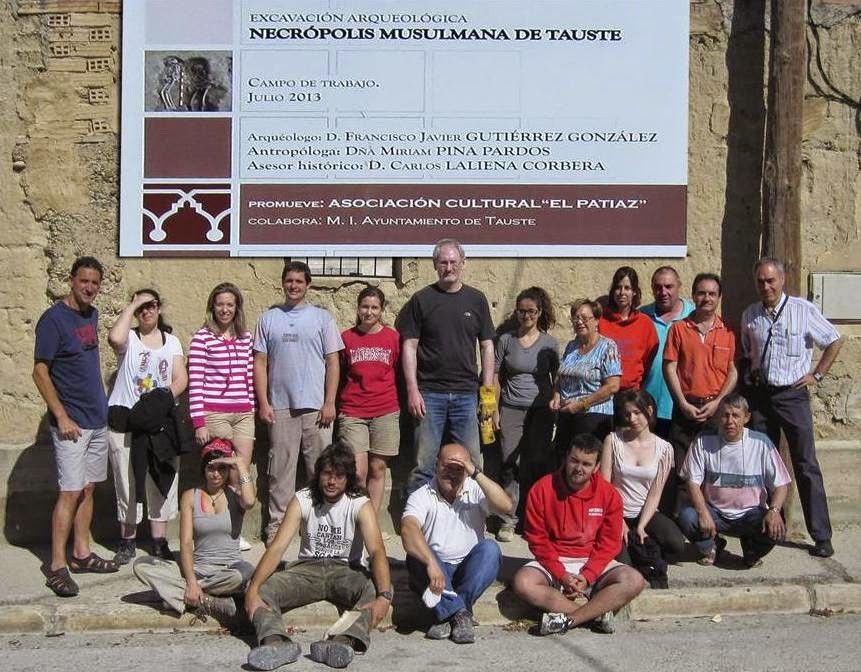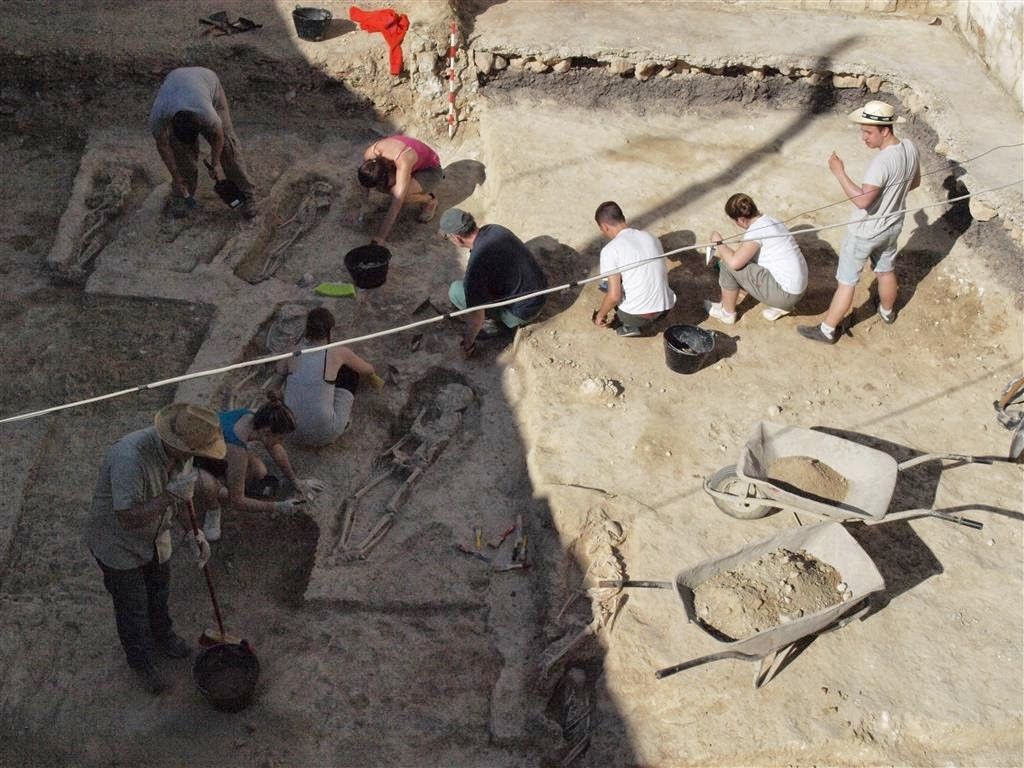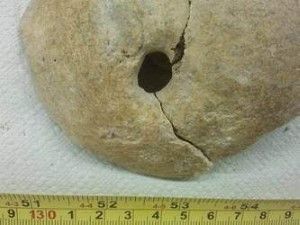Introduction. –
After the discovery in 2010 of a major Islamic cemetery in the widening zone of the urban area of Tauste and the confirmation of its great importance by the tests conducted in 2011 and 2012, in the year 2013 was excavated during the month of July on a private property plot located in Obispo José Mª Conget Avenue, where all the indications point that in this place there was a significant number of burials in this cemetery.
This excavation was sponsored by the Cultural Association “The Patiaz”, a lacking profit organization, established in Tauste, which, among its objectives, has the promotion, protection and dissemination of cultural heritage town, always with the cooperation of the City Hall of Tauste
In the picture multidisciplinary team in 2013 worked in the excavation with the archaeologist director Francisco Javier Gutierrez, Dr. Carlos Laliena professor Zaragoza University and university students.
During years 2011 and 2012 some tombs appeared in the street.

Found 24 tombs in the phase IV of the islamic necropolis excavations of Tauste.
During July 2013, intensive work was carried out in the Phase IV of Excavations of the Islamic Necropolis of Tauste. Promoted by the Cultural Association “The Patiaz”, the project has been funded with the own means of the Association and a campaign of micro-donations or crowdfunding where people have responded satisfactorily.
Under the direction of the archaeologist Mr. Francisco Javier Gutierrez Gonzalez and counselling of the professor of Medieval History Mr. Carlos Laliena Corbera, twenty-two university students of different specialties and from different places of Spain worked in Tauste during a month, doing internships of archeology, anthropology, anatomy, topography and history.
Spectacular results were achieved. In 103 m2 explored , a total of 24 tombs with human remains in different states of conservation have been found, all of Islamic typology with the bodies on the right side and oriented towards Mecca.
Three of the graves stand out for the typical form of burial of double pit and double grave. We also highlight one grave in which a skeleton appeared with signs of healing in life of a fracture in tibia and fibula.
There are 44 tombs altogether found during the four excavations carried out, between men, women and children. In this excavation work it has also been found an earring of bronze, unusual finding in the Muslim graves.
It is not the first time that this cemetery surprises with a curious finding. In the previous phase, a trepanning skull with signs of survival, a technique which consisted of piercing the skull with a stone or metal instrument, was found.
This anthropological study was done by the Anthropologist Miriam Pina, who came to interesting conclusions on this necropolis covering the entire period of Muslim domination in the Valley of the Ebro ( VIII to XII centuries), essential to the knowledge of the first Islamic communities in this area. Its great length and density already give evidence of the existence of a significant population in Tauste at that time.
The discovery of this necropolis also supports other conclusions of the kind of the tower of this locality, listed as XIII century mudejar, was a minaret of the XI century corresponding to the main mosque of Tauste reused as a bell-tower. Members of the Department of Conservation of the Heritage of the Government of Aragon, concerned by the excavation results, have visited Tauste in several occasions.
Media broadcasting and television, in addition to website specialized in archaeology and anthropology, also were interested in our findings. Here some links. Canal 24 Horas RTV nationally and Aragon TV in our autonomous community made extensive excavations covering.
Project –
Estimations calculated by archaeologist D. Francisco Javier González Gutiérrez foresee an extension from two to three acres for this cemetery, with about 4,500 burials.
They appear as the Islamic rite: lying on the right side and facing Mecca. The radiocarbon tests conducted by the CSIC provide a dating from the early years of Islam arrival to the Ebro valley (year 714) until the eleventh century, covering almost the four centuries of Muslim control in the region.
The discovery of this cemetery represents a major shift in terms of historical considerations in Tauste, the evidence that in this place a stable population was established and reached a demographic level and of development unsuspected up to now.
Other recent research in architecture came to demonstrate that the tower of St. Mary (considered as “Mudejar tower”) could be an construction also of the same era. The population discovered in the necropolis provides the necessary evidence to belive about the existence of a magnificent minaret of taifal islamic period in Tauste in those centuries.
From the discovery of this necropolis up to now, there is interesting things like as trepanation in a skull and the evidence that the individual survived such intervention, possibly done for therapeutic purposes.
Throughout the three archaeological excavations carried out in this necropolis had been great interest, for both especialists and global population, to see of these findings as they are discovered. Guided tours showed this excavation with open tombs and appropriate explanations about the characteristics of a Muslim cemetery, burial forms, historical data and other caracteristic.
Site plans. –
Necropolis situation within the urban plane and plot of the field work
Given the importance of the finding, the Cultural Association “The Patiaz” keeps in touch with organizations related to the academic world (archeology and anthropology), and the media (press, radio and television).
Spanish Society of Physical Anthropology.
The Spanish Society of Physical Anthropology (SEAF) is a non-profit organization aimed at promoting research and disseminating knowledge in the field of Physical Anthropology. This society is the editor of the Spanish Journal of Physical Anthropology (REAF)
It is a scientific non-profit association. It was founded in 1947 and took its name in honor of the prominent researcher Telesforo Aranzadi (1860-1945). Chartered as a Centre of Study and Research, Aranzadi has become a benchmark for the scientific community as evidenced by the recognition, acquired in 2001, of Public Interest Entity.
Acknowledgement

The translation of this page is included in the Zaragoza Provincial Council Grants for the Dissemination and Revitalisation of Cultural Heritage in the year 2022.
La traducción de está página esta incluida dentro de las Ayudas de la Diputación Provincial de Zaragoza para la Difusión y Dinamización del Patrimonio Cultural en el año 2022.








